现在完成时态讲解
- 格式:doc
- 大小:41.00 KB
- 文档页数:7

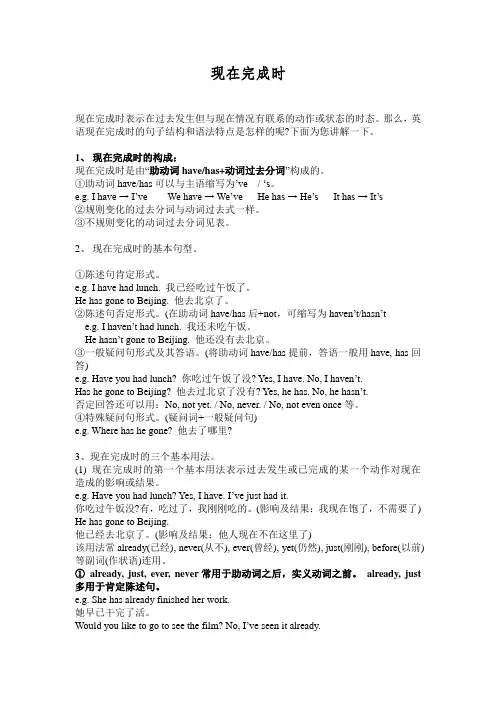
现在完成时现在完成时表示在过去发生但与现在情况有联系的动作或状态的时态。
那么,英语现在完成时的句子结构和语法特点是怎样的呢?下面为您讲解一下。
1、现在完成时的构成:现在完成时是由“助动词have/has+动词过去分词”构成的。
①助动词have/has可以与主语缩写为‟ve / …s。
e.g. I have → I‟ve We have → We‟ve He has → He‟s It has → It‟s②规则变化的过去分词与动词过去式一样。
③不规则变化的动词过去分词见表。
2、现在完成时的基本句型。
①陈述句肯定形式。
e.g. I have had lunch. 我已经吃过午饭了。
He has gone to Beijing. 他去北京了。
②陈述句否定形式。
(在助动词have/has后+not,可缩写为haven‟t/hasn‟te.g. I haven‟t had lunch. 我还未吃午饭。
He hasn‟t gone to Beijing. 他还没有去北京。
③一般疑问句形式及其答语。
(将助动词have/has提前,答语一般用have, has回答)e.g. Have you had lunch? 你吃过午饭了没? Yes, I have. No, I haven‟t.Has he gone to Beijing? 他去过北京了没有? Yes, he has. No, he hasn‟t.否定回答还可以用:No, not yet. / No, never. / No, not even once等。
④特殊疑问句形式。
(疑问词+一般疑问句)e.g. Where has he gone? 他去了哪里?3、现在完成时的三个基本用法。
(1) 现在完成时的第一个基本用法表示过去发生或已完成的某一个动作对现在造成的影响或结果。
e.g. Have you had lunch? Yes, I have. I‟ve just had it.你吃过午饭没?有,吃过了,我刚刚吃的。
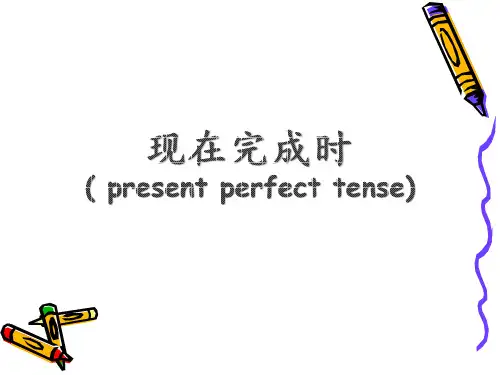


现在完成时讲解LEKIBM standardization office【IBM5AB- LEKIBMK08- LEKIBM2C】现在完成时讲解一.基本结构:助动词have/has+过去分词(done)二.句型:否定句:主语+have/has+not+过去分词+其他. 一般疑问句:Have/Has+主语+过去分词+其他. 简略答语: Yes, 主语 + have/has.(肯定) No, 主语 + haven't/hasn't.(否定)三.用法(1)现在完成时表示过去发生或已经完成的动作对现在造成的影响或结果I have spent all of my money (so far).(含义是:现在我没有钱花了.)Guo zijun has (just/already) come. (含义:郭子君现在在这儿)My father has gone to work.(含义是:我爸爸现在不在这儿)(2)现在完成时可以用来表示发生在过去某一时刻的,持续到现在的动作(用行为动词表示)或状态(be动词表示)常与for(+时间段),since(+时间点或过去时的句子)连用.①for+时段②since+过去一个时间点(译为:自从……以来)③since+时段+ago④since+从句(过去时)⑤It is+时段+since+从句(过去时)Mary has been ill for three days.I have lived here since 1998.四.has gone (to),has been (to), has been (in) 的区别Have/Has gone(to) :去了(现在不在说话现场)Where is your father?He has gone to Shanghai.Have/Has been (to) :去过(已不在去过的地方)My father has been to Shanghai.Have/has been in:呆了多久(还在所呆的地方)My father has been in Shanghai for two months. /since two months ago.五.现在完成时的标志1.现在完成时的含义之一是过去完成的动作对现在仍有影响,用以下四大标志词可以表达这种含义:* 以already, just和yet为标志He has already got her help.他已得到她的帮助。
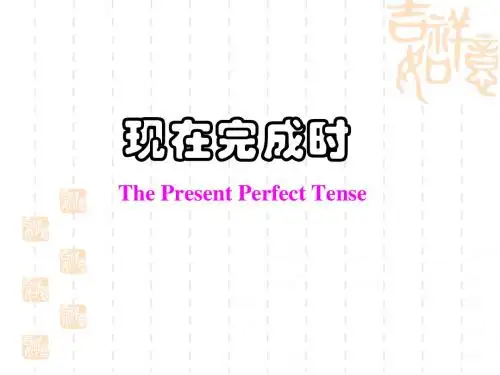

现在完成时时态讲解一、意义现在完成时表示过去发生的动作或状态对现在造成的影响或结果。
They have left. --他们已经离开了(也就是说现在他们人不在这里) I have had my lunch. --我已经吃过午饭了(也就是说我现在不饿) 二·谓语动词的构成形式:: have /has (助动词)+done(过去分词)例:Have you lost your library book? 你已经弄丢了从图书馆借的那本书吗? 5现在完成时态还常常用于下列句型They have planted many trees in the last few years. 在过去的几年,他们已经种了很多树。
This is the best book I have ever read. 这是我曾经读过的最好的一本书。
It is the first time I have played the computer games. 这是我第一次玩电脑游戏。
6. 延续性动词和终止性动词 ①延续性动词:表示的动作是能延续的动作,这种动作可以延续下去或产生持久的影响。
如:learn work stand lie know walk keep have wait watch sing read sleep live②终止性动词:也叫非延续性动词,瞬间动词,一次性动词。
表示的动作不能延续,即动作发生后立即结束,产生某种结果。
在有了某种结果后,动作就不能再继续下去。
如:leave start set out arrive reach get to begin stop shut turn off marry put put on get up wake fall join meet receivefinish end complete become come go die open close break give jump buy borrow7. 终止性动词不能和一段时间状语连用,所以终止性动词不能用于现在完成时态的肯定句。


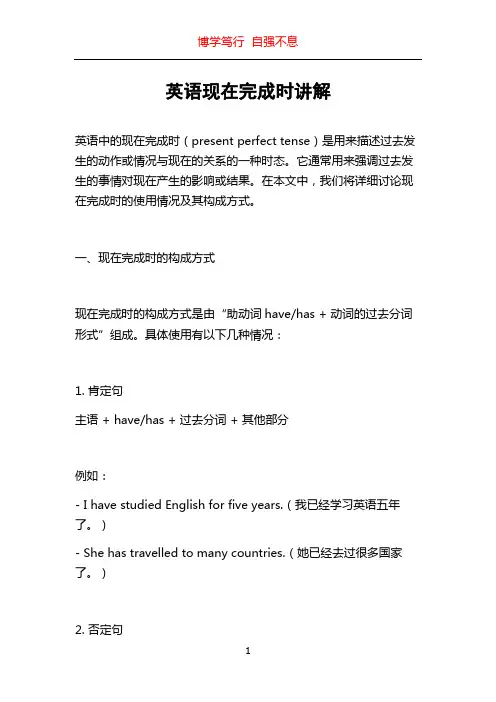
英语现在完成时讲解英语中的现在完成时(present perfect tense)是用来描述过去发生的动作或情况与现在的关系的一种时态。
它通常用来强调过去发生的事情对现在产生的影响或结果。
在本文中,我们将详细讨论现在完成时的使用情况及其构成方式。
一、现在完成时的构成方式现在完成时的构成方式是由“助动词have/has + 动词的过去分词形式”组成。
具体使用有以下几种情况:1. 肯定句主语 + have/has + 过去分词 + 其他部分例如:- I have studied English for five years.(我已经学习英语五年了。
)- She has travelled to many countries.(她已经去过很多国家了。
)2. 否定句主语 + have/has + not + 过去分词 + 其他部分例如:- He hasn't finished his work yet.(他还没有完成工作。
)- We haven't seen each other for a long time.(我们已经很久没有见面了。
)3. 疑问句Have/Has + 主语 + 过去分词 + 其他部分?例如:- Have you ever visited Paris?(你曾经去过巴黎吗?)- Has she seen the latest movie?(她看过最新的电影吗?)二、现在完成时的使用情况现在完成时通常用于以下几种情况:1. 表示过去开始的动作一直延续至今或刚刚结束的情况。
例如:- I have lived in this city for ten years.(我在这个城市已经住了十年了。
)- They have worked on this project since last month.(他们从上个月开始就一直在做这个项目。
)2. 表示过去发生的动作对现在产生的影响或结果。
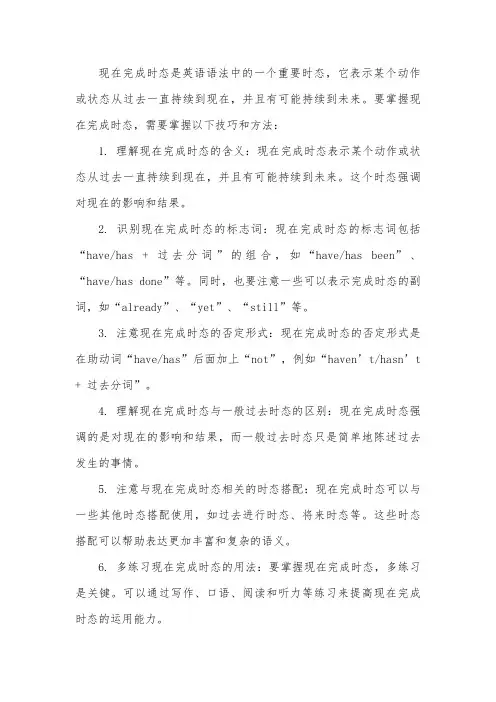
现在完成时态是英语语法中的一个重要时态,它表示某个动作或状态从过去一直持续到现在,并且有可能持续到未来。
要掌握现在完成时态,需要掌握以下技巧和方法:
1. 理解现在完成时态的含义:现在完成时态表示某个动作或状态从过去一直持续到现在,并且有可能持续到未来。
这个时态强调对现在的影响和结果。
2. 识别现在完成时态的标志词:现在完成时态的标志词包括“have/has + 过去分词”的组合,如“have/has been”、“have/has done”等。
同时,也要注意一些可以表示完成时态的副词,如“already”、“yet”、“still”等。
3. 注意现在完成时态的否定形式:现在完成时态的否定形式是在助动词“have/has”后面加上“not”,例如“haven’t/hasn’t + 过去分词”。
4. 理解现在完成时态与一般过去时态的区别:现在完成时态强调的是对现在的影响和结果,而一般过去时态只是简单地陈述过去发生的事情。
5. 注意与现在完成时态相关的时态搭配:现在完成时态可以与一些其他时态搭配使用,如过去进行时态、将来时态等。
这些时态搭配可以帮助表达更加丰富和复杂的语义。
6. 多练习现在完成时态的用法:要掌握现在完成时态,多练习是关键。
可以通过写作、口语、阅读和听力等练习来提高现在完成时态的运用能力。
总之,要掌握现在完成时态,需要理解其含义、标志词、否定形式以及与其它时态的区别,并多加练习。
同时,注意理解对现在的影响和结果,这是这个时态的核心要点。
现在完成时讲解一、现在完成时的结构:助动词have/has+动词过去分词二、动词过去分词的构成规则动词:规则动词的过去分词的构成规则与规则动词的过去式的构成规则相同。
四点变化规则:(1)、一般动词,在词尾直接加“ ed ”。
finishfinishedfinished, visitvisitedvisited(2)、以“ e ”结尾的动词,只在词尾加“ d ”。
change—changed— changed, livelivedlived ,(3)、以“辅音字母+ y ”结尾的动词,将“y” 变为“i” ,再加“ ed ”。
carrycarriedcarried, crycriedcried(4)、重读闭音节结尾,末尾只有一个辅音字母,先双写该辅音字母,再加“ ed ”。
stopstoppedstopped, dropdroppeddropped不规则动词过去分词的构成三、现在完成时的主要用法1、表示过去所发生的动作对现在造成的影响和结果。
He has just turned off the light. 他刚把灯关了。
(强调现在灯不亮了)He turned off the light. 他关过灯。
(只说明过去某个时刻他关过灯,但不强调现在灯是否亮着)2、表示从过去某一时刻开始并一直延续到现在的动作或状态,这种动作或状态可能仍在继续。
She has lived here since she was born. 她自出生以来就一直住在这儿。
I have learnt English for more than ten years. 我已经学了10多年的英语了。
现在完成时的基本句型①陈述句肯定形式。
主语+ have/has+ 过去分词+其它e.g. I have had lunch. 已经吃过午饭了。
He has gone to Beijing. 他去北京了。
①陈述句否定形式。
主语+ have/has+ not+过去分词+…(在助动词have/has后+not,可缩写为haven’t/hasn’t)e.g.I haven’t had lunch. 我还没吃午饭He hasn’t gone to Beijing. 他还没有去北京。
现在完成时的用法讲解一、现在完成时的基本概念和构成现在完成时是英语中一个常用的时态,用来表示过去发生或已经完成的动作与现在的关系。
它由助动词“have/has”和动词的过去分词构成,其中“have”用于第一人称和第二人称,而“has”则用于第三人称单数。
二、现在完成时的基本用法1. 表示过去开始并持续到现在的动作或状态:例如:I have worked in this company for five years.(我已经在这家公司工作五年了。
)2. 表示过去曾经做过的事情对当前造成影响或产生结果:例如:She has lost her keys, so she can't open the door.(她丢失了钥匙,所以无法打开门。
)3. 表示某个时间点之前已经发生或完成的动作:例如:I have already finished my homework.(我已经完成了我的家庭作业。
)三、与时间状语连用的特殊情况1. 使用含有未来概念的时间状语时,需使用将来完成时代替现在完成时:例如:By next week, I will have finished this project.(到下周,我将会完成这个项目。
)2. 使用指定时间点为止加上“for”或“since”的状语时:例如:I have been studying English for five years.(我已经学习英语五年了。
)例如:He has lived in London since 2010.(他自2010年以来一直住在伦敦。
)四、与其他时态的对比1. 与一般过去时对比:现在完成时强调动作带来的结果或影响,而一般过去时则着重指明具体发生的时间点。
2. 与过去完成时对比:现在完成时强调过去到现在产生的影响或结果,而过去完成时则强调过去某个时间点之前已经完成的动作。
3. 与将来完成时对比:将来完成时用于表示将来某个时间点之前已经发生或已经完成的事情,而现在完成时则用于表示从过去某个时间点开始到现在所持续的动作或状态。
英语现在完成时态知识点梳理归纳总结英语是一门广泛使用的语言,掌握好英语的时态是学习英语的关键之一。
其中,现在完成时态是英语中较为复杂和常用的一种时态,因此对其进行深入的了解和掌握是学习英语的基础。
本文将对英语现在完成时态的知识点进行梳理、归纳和总结。
一、现在完成时态的构成与用法1. 构成:现在完成时态由“have/has + 过去分词”构成。
其中,have用于第一人称和第二人称(I、you、we、they),has用于第三人称单数(he、she、it)。
2. 用法:(1)表示过去某个时间点开始,持续到现在仍在进行的动作或状态。
例如:I have lived in this city for 10 years.(我在这个城市住了10年了。
)(2)表示过去某个时间点发生的动作对现在产生的影响或结果。
例如:I have finished my homework, so I can go out to play.(我已经完成作业了,所以我可以出去玩。
)(3)用于经验、经历、成就等方面的表达。
例如:I have visited Paris twice.(我去过巴黎两次。
)3. 时间状语的使用:现在完成时态常与以下时间状语连用,如already(已经)、just (刚刚)、yet(还、已经)等。
例如:Have you finished your work yet?(你的工作做完了吗?)二、现在完成时态与其他时态的区别1. 现在完成时态与一般过去时:现在完成时态强调过去发生的动作与现在的联系,而一般过去时则仅仅表示过去发生的动作,没有现在的联系。
例如:They have cleaned the room.(他们已经打扫了房间。
)(现在完成时态)They cleaned the room yesterday.(他们昨天打扫了房间。
)(一般过去时)2. 现在完成时态与过去进行时:现在完成时态强调的是动作的完成,而过去进行时则强调的是动作的进行。
现在完成时的讲解时态 - 现在完成时1.概念:过去发生或已经完成的动作对现在造成的影响或结果,或从过去已经开始,持续到现在的动作或状态。
(看看就好)2.基本结构:have/has + done否定形式:have/has + not +done.一般疑问句:have或has+主语+done4、使用现在完成时时需要注意的事项:(1)、现在完成时和一般过去式的区别:现在完成时和一般过去式都表示在过去做过的事情,但是现在完成时更加趋向于表示过去已经完成的动作对于现在的影响,而一般过去式只是陈述事实,不包含个人的感情色彩。
句中当有现在完成时的时间状语时,就必须使用现在完成时,然而句中有ago、last、when、the other day、last week 、just now、during the night等时就只能使用一般过去式。
还有一些没有限定的时间状语:this morning 等,要看语境决定。
(2)点动词:(即非延续性动词、瞬间动词)瞬间动词不可以和表示延续时间的现在完成时连用,但可以将瞬间动词变换为其对应的延续性动词:leave --- be away, borrow --- keep, buy --- have, begin/start --- be on, die --- be dead, finish --- be over, join --- be in+组织机构, be a member of+组织机构, open sth --- keep sth open, fall ill --- be ill, get up---be up, catch a cold --- have a cold, come here --- be here, go there --- be there, become --- be, come back --- be back, fall asleep --- be asleep, get to/ arrive/reach --- be (in), leave --- be away from, get to know --- know, go (get) out →be out,put on→ wear;catch a cold →have a cold(3)过去完成时和现在完成时的区别:过去完成时表示事件发生在过去的过去,表示过去某个时间点完成的动作对于过去的更近的一个时间点有影响(jerry在这里暂且不深说),现在完成时主要是强调过去某个时间点完成的动作对现在有影响。
时态讲解:现在完成时(1)构成:现在完成时由助动词have + 过去分词构成,助动词have 有人称和数的变化。
第三人称单数用has,其余用have.现在完成时的否定式直接在助动词后面加上not、疑问式是把助动词提到主语之前。
以study 为例,其否定式、疑问式和简单回答形式如下:否定式疑问式I have not (haven’t) studied….Have I studied…?You have not (haven’t) studied….Have you studied…?He has not (hasn’t) studied….Has he studied…?否定疑问式简单回答(肯定/否定)Have I not (Haven’t I) studied…?Yes, you have. No, you haven’t.Have you not (Haven’t you) studied…?Yes, I have. No, I haven’t.Has he not (Hasn’t he) studied…?Yes, he has. No, he has n’t.(2)用法:1)现在完成时通常表示在说话之前已经完成的动作或存在的状态。
说话人强调的是该动作或状态对现在的结果或影响。
My daughter has just gone out. 我女儿刚出去。
我肯定我们以前见过面。
I’m sure we’ve met before.She has arrived. 她到了。
2)表示持续到现在的动作或状态,往往和包括现在在内的表示一段时间的状语连用,如recently, already, just, yet等。
如:lately, for…,since…,I haven’t heard from her these days. 这些日子我没有收到她的信。
We haven’t seen you recently. 最近我们没有见到你。
现在完成时讲解
一.基本结构:助动词have/has+过去分词(done)
二.句型:
否定句:主语+have/has+not+过去分词+其他. 一般疑问句:Have/Has+主语+过去分词+其他.
简略答语: Yes, 主语+ have/has.(肯定) No, 主语+ haven't/hasn't.(否定)
三.用法
(1)现在完成时表示过去发生或已经完成的动作对现在造成的影响或结果
I have spent all of my money (so far).(含义是:现在我没有钱花了.)
Guo zijun has (just/already) come. (含义:郭子君现在在这儿)
My father has gone to work.(含义是:我爸爸现在不在这儿) (2)现在完成时可以用来表示发生在过去某一时刻的,持续到现在的动作(用行为动词表示)或状态(be动词表示)常与for(+时间段),since(+时间点或过去时的句子)连用.
①for+时段
②since+过去一个时间点(译为:自从……以来)
③since+时段+ago
④since+从句(过去时)
●⑤It is+时段+since+从句(过去时)
Mary has been ill for three days.
I have lived here since 1998.
四.has gone (to),has been (to), has been (in) 的区别
Have/Has gone(to) :去了(现在不在说话现场)
Where is your father?He has gone to Shanghai.
Have/Has been (to) :去过(已不在去过的地方)
My father has been to Shanghai.
Have/has been in:呆了多久(还在所呆的地方)
My father has been in Shanghai for two months. /since two months ago.
五.现在完成时的标志
1. 现在完成时的含义之一是过去完成的动作对现在仍有影响,用以下四大标志词可以表达这种含义: * 以already, just和yet为标志
He has already got her help. 他已得到她的帮助。
He has just seen the film. 他刚刚看过这场电影。
He hasn't come back yet. 他还没有回来。
* 以ever和never为标志
This is the best film I have ever seen. 这是我曾经看过的最好的一部电影。
He has never been to Beijing. 他从没有到过北京。
* 以动作发生的次数为标志
He says he has been to the USA three times. 他说他已经去过美国三次了。
* 以so far(到目前为止)为标+before
He has got to Beijing so far. 到目前为止他已到了北京。
She has passed the examso far. 到目前为止她已经通过了考试。
2.过去已经开始的动作一直延续到现在, 甚至有可能继续延续下去,我们可以从动作“延续”的特性和“时间”点段的区分入手,进一步学习现在完成时。
* ①for+时段②since+过去一个时间点(过去从句)为标志
注意:1)现在完成时不能单独与过去的时间状语连用, 如yesterday,last week, three years ago 等; 2)不能与when连用 2.现在完成时往往同表示不确定的过去时间状语连用
六.过去分词
1 、规则动词:规则动词的过去分词的构成规则与规则动词的过去式的构成规则相同。
四点变化规则:
(1)、一般动词,在词尾直接加“ ed ”。
work---worked---worked ,visit---visited---visited
(2)、以“ e ”结尾的动词,只在词尾加“ d ”。
live---lived---lived ,
(3)、以“辅音字母+ y ”结尾的动词,将"y" 变为"i" ,再加“ ed ”。
study---studied---studied ,cry---cried---cried
(4)、重读闭音节结尾,末尾只有一个辅音字母,先双写该辅音字母,再加“ ed ”。
stop---stopped---stopped , drop---dropped--dropped
2 、不规则动词见不规侧动词变化表:
特殊词:
★1.have代替buy
My brother has had(不能用has bought) this bike for almost four years. ★2、用keep或have代替borrow
I have kept(不能用have borrowed) the book for quite a few days.
★3、用be替代become
How long has your sister been a teacher?
★4、用have a cold代替catch a cold
Tom has had a cold since the day before yesterday.
★5、用wear代替put on
b)用“be+形容词”代终止性动词
1、be+married代marry
2、be+ill代fall (get) ill
3、be+dead代die
4、be+asleep代fall (get) asleep
5、be+awake代wake/wake up
6、be+gone代lose,die,sell,leave
7、be+open代open 8、be closed代close/shut
9、be+missing(gone,lost)代lose
c)用“be+副词”代终止性动词
1“be+on”代start,begin
2“be+up”代get up
3“be+back(to)”代return to,come back to,go back to
4“be here (there)”代come(arrive,reach,get) here或go (arrive,reach,get) there等等
d)用“be+介词短语”代终止性动词
1.“be in/at +地点”代替go to /come to
2.用be in the army 代替join the army
3.“be in/at +地点”代替move to
常用瞬间动词变延续性动词表:
1. have arrived at/in sw. got to/reached sw. come/gone/moved to sw.
→have been in sw./at…相应的介词
2. have come/gone back/returned → have been back
3. have come/gone out →have been out
4. have become →have been
5. have closed / opened→ have been close/open
6. have got up → have been up;
7. have died → have been dead;
8. have left sw. → have been away from sw.
9. have fallen asleep/got to sleep → have been asleep;
10. have finished/ended/completed → hav e been over;
11. havemarried → have been married;
12. have started/begun to do sth. → have done sth. ;
13. have begun → have been on
14. have borrowed/bought →have kept/had
15. have lost → haven’t had
16. have put on →have worn
17. have caught /get a cold → have had a cold;
18. have got to know → have known
19. have/has gone to → have been in
20. have joined/have taken part in the league/the Party/the army。